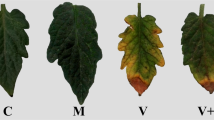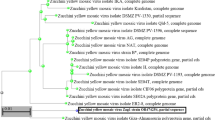Abstract
Beet curly top Iran virus (BCTIV), a member of the genus Becurtovirus, is one of the causal agents for curly top disease in tomato plants. Arbuscular mycorrhizal (AM) fungi provide nutrients for host plants and are associated with their improved growth. However, the impact of AM on infection by plant viruses is not well understood. In this study, the interaction between Funneliformis mosseae and BCTIV in a susceptible tomato cultivar (Early Eurbana) was investigated. In a completely randomized design experiment, tomato seedlings were inoculated with F. mosseae, and after 4 weeks, they were inoculated with an infectious clone of BCTIV. Four treatments were included: untreated control plants (C), BCTIV-infected plants (V), mycorrhizal plants (M) and BCTIV-infected mycorrhizal plants (MV). Results of symptom evaluation based on a disease severity index showed a higher disease severity in MV plants compared to V plants. Supporting this result, a higher level of virus accumulation was observed in MV plants and this became more significant after long-term infection. The expression of three defense-related genes including HSP90, RLK and PRP1 was attenuated in MV plants compared to V plants, which may explain the enhanced symptom production and viral accumulation in these plants. A similar percentage of root colonization by F. mosseae in M and MV plants indicated that root colonization was not affected by BCTIV infection. These results show that mycorrhizal symbiosis increases the susceptibility of tomato plants to virus infection and favors BCTIV accumulation and symptom production.





Similar content being viewed by others
References
Arunachalam P, Radhakrishnan V, Mathew SK, Kumar PS (2002) Reaction of bitter gourd genotypes against distortion mosaic virus. Veg Sci 29:55–57
Beckers GJ, Conrath U (2007) Priming for stress resistance: from the lab to the field. Curr Opin Plant Biol 10:425–431
Blee KA, Anderson AJ (2002) Transcripts for genes encoding soluble acid invertase and sucrose synthase accumulate in root tip and cortical cells containing mycorrhizal arbuscules. Plant Mol Biol 50:197–211
Borer ET, Seabloom EW, Mitchell CE, Power AG (2010) Local context drives infection of grasses by vector-borne generalist viruses. Ecol Lett 13:810–818
Catoni M, Miozzi L, Fiorilli V, Lanfranco L, Accotto GP (2009) Comparative analysis of expression profiles in shoots and roots of tomato systemically infected by Tomato spotted wilt virus reveals organ-specific transcriptional responses. Mol Plant Microbe Interact 22:1504–1513
Cervantes-Gamez RG, Bueno-Ibarra MA, Cruz-Mend A, Calderon-Vazquez CL, Ramırez-Douriet CM et al (2015) Arbuscular mycorrhizal symbiosis-induced expression changes in Solanum lycopersicum leaves revealed by RNA-seq analysis. Plant Mol Biol Rep 34:89–102
Daft M, Okusanya B (1973) Effect of endogone mycorrhiza on plant growth v. influence of infection on the multiplication of viruses in tomato, petunia and strawberry. New Phytol 72:975–983
De La Peña E, Echeverría SR, Van Der Putten WH, Freitas H, Moens M (2006) Mechanism of control of root-feeding nematodes by mycorrhizal fungi in the dune grass Ammophila arenaria. New Phytol 169:829–840
Dehne H (1982) Interaction between vesicular-arbuscular mycorrhizal fungi and plant pathogens [Fungi, viruses, nematodes]. agris.fao.org
Dumas-Gaudot E, Gollotte A, Cordier C, Gianinazzil S, Gianinazzi-Pearson V (2000) Modulation of host defence systems. In: Kapulnik Y, Douds DD (eds) Arbuscular mycorrhizas: physiology and function. Springer, Netherlands, pp 173–200
Eini O, Sahraei GE, Behjatnia SAA (2016) Molecular characterization and construction of an infectious clone of a pepper isolate of Beet curly top Iran virus. Mol Biol Res Commun 5:101–113
Fakhro A, Andrade-Linares DR, von Bargen S, Bandte M, Büttner C, Grosch R, Schwarz D, Franken P (2010) Impact of Piriformospora indica on tomato growth and on interaction with fungal and viral pathogens. Mycorrhiza 20:191–200
Fiorilli V, Catoni M, Miozzi L, Novero M, Accotto GP, Lanfranco L (2009) Global and cell-type gene expression profiles in tomato plants colonized by an arbuscular mycorrhizal fungus. New Phytol 184:975–987
Fiorilli V, Catoni M, Francia D, Cardinale F, Lanfranco L (2011) The arbuscular mycorrhizal symbiosis reduces disease severity in tomato plants infected by Botrytis cinerea. J Plant Pathol 93:237–242
Fontes EP, Santos AA, Luz DF, Waclawovsky AJ, Chory J (2004) The geminivirus nuclear shuttle protein is a virulence factor that suppresses transmembrane receptor kinase activity. Genes Dev 18:2545–2556
Friedmann M, Lapidot M, Cohen S, Pilowsky M (1998) A novel source of resistance to tomato yellow leaf curl virus exhibiting a symptomless reaction to viral infection. J Am Soc Hortic Sci 123:1004–1007
Fritz M, Jakobsen I, Lyngkjær MF, Thordal-Christensen H, Pons-Kühnemann J (2006) Arbuscular mycorrhiza reduces susceptibility of tomato to Alternaria solani. Mycorrhiza 16:413–419
García-Chapa M, Batlle A, Laviña A, Camprubí A, Estaún V, Calvet C (2004) Tolerance increase to pear decline phytoplasma in mycorrhizal OHF-333 pear rootstock. Acta Hortic 657:437–441
Gernns H, Alten H, Poehling H-M (2001) Arbuscular mycorrhiza increased the activity of a biotrophic leaf pathogen—Is a compensation possible? Mycorrhiza 11:237–243
Gorovits R, Moshe A, Amrani L, Kleinberger R, Anfoka G, Czosnek H (2017) The six Tomato yellow leaf curl virus genes expressed individually in tomato induce different levels of plant stress response attenuation. Cell Stress Chaperones 22:345–355
Guether M, Balestrini R, Hannah M, He J, Udvardi MK, Bonfante P (2009) Genome-wide reprogramming of regulatory networks, transport, cell wall and membrane biogenesis during arbuscular mycorrhizal symbiosis in Lotus japonicus. New Phytol 182:200–212
Hause B, Mrosk C, Isayenkov S, Strack D (2007) Jasmonates in arbuscular mycorrhizal interactions. Phytochemistry 68:101–110
Heydarnejad J, Keyvani N, Razavinejad S, Massumi H, Varsani A (2013) Fulfilling Koch’s postulates for beet curly top Iran virus and proposal for consideration of new genus in the family Geminiviridae. Adv Virol 158:435–443
Hildebrandt U, Regvar M, Bothe H (2007) Arbuscular mycorrhiza and heavy metal tolerance. Phytochemistry 68:139–146
Javot H, Pumplin N, Harrison MJ (2007) Phosphate in the arbuscular mycorrhizal symbiosis: transport properties and regulatory roles. Plant, Cell Environ 30:310–322
Kanakala S, Verma H, Vijay P, Saxena D, Malathi V (2013) Response of chickpea genotypes to Agrobacterium-mediated delivery of Chickpea chlorotic dwarf virus (CpCDV) genome and identification of resistance source. Appl Microbiol Biotechnol 97:9491–9501
Kardani SG, Heydarnejad J, Zakiaghl M, Mehrvar M, Kraberger S, Varsani A (2013) Diversity of Beet curly top Iran virus isolated from different hosts in Iran. Virus Genes 46:571–575
Khaosaad T, Garcia-Garrido J, Steinkellner S, Vierheilig H (2007) Take-all disease is systemically reduced in roots of mycorrhizal barley plants. Soil Biol Biochem 39:727–734
Khoshnazar F, Eini O (2016) Response of tomato cultivars to agroinfection with Beet curly top Iran virus. J Crop Prot 5:473–482
Li HY, Yang GD, Shu HR, Yang YT, Ye BX, Nishida I, Zheng C-C (2006) Colonization by the arbuscular mycorrhizal fungus Glomus versiforme induces a defense response against the root-knot nematode Meloidogyne incognita in the grapevine (Vitis amurensis Rupr.), which includes transcriptional activation of the class III chitinase gene VCH3. Plant Cell Physiol 47:154–163
Lingua G, D’Agostino G, Massa N, Antosiano M, Berta G (2002) Mycorrhiza-induced differential response to a yellows disease in tomato. Mycorrhiza 12:191–198
Liu J, Maldonado-Mendoza I, Lopez-Meyer M, Cheung F, Town CD, Harrison MJ (2007) Arbuscular mycorrhizal symbiosis is accompanied by local and systemic alterations in gene expression and an increase in disease resistance in the shoots. Plant J 50:529–544
Livak KJ, Schmittgen TD (2001) Analysis of relative gene expression data using real-time quantitative PCR and the 2 − ΔΔCT method. Methods 25:402–408
López-Ráez JA, Verhage A, Fernández I, García JM, Azcón-Aguilar C, Flors V, Pozo MJ (2010) Hormonal and transcriptional profiles highlight common and differential host responses to arbuscular mycorrhizal fungi and the regulation of the oxylipin pathway. J Exp Bot 61:2589–2601
Maffei G, Miozzi L, Fiorilli V, Novero M, Lanfranco L, Accotto GP (2014) The arbuscular mycorrhizal symbiosis attenuates symptom severity and reduces virus concentration in tomato infected by Tomato yellow leaf curl Sardinia virus (TYLCSV). Mycorrhiza 24:179–186
Miozzi L, Catoni M, Fiorilli V, Mullineaux PM, Accotto GP, Lanfranco L (2011) Arbuscular mycorrhizal symbiosis limits foliar transcriptional responses to viral infection and favors long-term virus accumulation. Mol Plant Microbe Interact 24:1562–1572
Moshe A, Gorovits R, Liu Y, Czosnek H (2016) Tomato plant cell death induced by inhibition of HSP90 is alleviated by Tomato yellow leaf curl virus infection. Mol Plant Pathol 17:247–260
Ozgonen H, Erkilic A (2007) Growth enhancement and Phytophthora blight (Phytophthora capsici Leonian) control by arbuscular mycorrhizal fungal inoculation in pepper. Crop Prot 26:1682–1688
Phillips JM, Hayman DS (1970) Improved procedures for clearing of roots and staining parasitic and vesicular-arbuscular mycorrhizal fungi for rapid assessment of infection. Trans Br Mycol Soc 55:158–161
Pozo MJ, Azcón-Aguilar C (2007) Unraveling mycorrhiza-induced resistance. Curr Opin Plant Biol 10:393–398
Pozo MJ, Cordier C, Dumas-Gaudot E, Gianinazzi S, Barea JM, Azcón-Aguilar C (2002) Localized versus systemic effect of arbuscular mycorrhizal fungi on defence responses to Phytophthora infection in tomato plants. J Exp Bot 53:525–534
Pozo MJ, Jung SC, López-Ráez JA, Azcón-Aguilar C (2010) Impact of arbuscular mycorrhizal symbiosis on plant response to biotic stress: The role of plant defence mechanisms. In: Koltai H, Kapulnik Y (eds) Arbuscular mycorrhizas: physiology and function. Springer, Netherlands, pp 193–207
Rosendahl S (1985) Interactions between the vesicular-arbuscular mycorrhizal fungus Glomus fascicuhtum and Aphanomyces euteiches root rot of peas. J Phytopathol 114:31–40
Rouhibakhsh A, Priya J, Periasamy M, Haq Q, Malathi V (2008) An improved DNA isolation method and PCR protocol for efficient detection of multicomponents of begomovirus in legumes. J Virol Methods 147:37–42
Salvioli A, Zouari I, Chalot M, Bonfante P (2012) The arbuscular mycorrhizal status has an impact on the transcriptome profile and amino acid composition of tomato fruit. BMC Plant Biol 12:44–55
Shaul O, Galili S, Volpin H, Ginzberg I, Elad Y, Chet I, Kapulnik Y (1999) Mycorrhiza-induced changes in disease severity and PR protein expression in tobacco leaves. Mol Plant Microbe Interact 12:1000–1007
Shen Q, Bao M, Zhou X (2012) A plant kinase plays roles in defense response against geminivirus by phosphorylation of a viral pathogenesis protein. Plant Signal Behav 7:888–892
Slezack S, Dumas-Gaudot E, Paynot M, Gianinazzi S (2000) Is a fully established arbuscular mycorrhizal symbiosis required for bioprotection of Pisum sativum roots against Aphanomyces euteiches? Mol Plant Microbe Interact 13:238–241
Soleimani R, Matic S, Taheri H, Behjatnia S, Vecchiati M, Izadpanah K, Accotto G (2013) The unconventional geminivirus Beet curly top Iran virus: satisfying Koch’s postulates and determining vector and host range. Ann Appl Biol 162:174–181
Song Y, Chen D, Lu K, Sun Z, Zeng R (2015) Enhanced tomato disease resistance primed by arbuscular mycorrhizal fungus. Front Plant Sci 6:786
Taylor J, Harrier LA (2003) Expression studies of plant genes differentially expressed in leaf and root tissues of tomato colonised by the arbuscular mycorrhizal fungus Glomus mosseae. Plant Mol Biol 51:619–629
Veresoglou SD, Rillig MC (2011) Suppression of fungal and nematode plant pathogens through arbuscular mycorrhizal fungi. Biol Let 8:214–217
Wehner J, Antunes PM, Powell JR, Mazukatow J, Rillig MC (2010) Plant pathogen protection by arbuscular mycorrhizas: a role for fungal diversity? Pedobiologia 53:197–201
Whipps JM (2004) Prospects and limitations for mycorrhizas in biocontrol of root pathogens. Can J Bot 82:1198–1227
Yazdi HB, Heydarnejad J, Massumi H (2008) Genome characterization and genetic diversity of Beet curly top Iran virus: a geminivirus with a novel nonanucleotide. Virus Genes 36:539–545
Acknowledgements
We thank Prof J.W. Randles (University of Adelaide) for reading the manuscript, Dr Rezaee-Danesh (University of Urmia) and Dr. Hemati (University of Zanjan) for their scientific comments and Behta Company (Tehran, Iran) for providing tomato seeds. This research was funded by the University of Zanjan, Iran.
Author information
Authors and Affiliations
Corresponding author
Ethics declarations
Conflict of interest
All authors declare that they have no conflict of interest. The authors of this manuscript had no financial or personal relationships with other people or organizations that could inappropriately influence the contents of this manuscript.
Additional information
Publisher's Note
Springer Nature remains neutral with regard to jurisdictional claims in published maps and institutional affiliations.
Electronic supplementary material
Below is the link to the electronic supplementary material.
Rights and permissions
About this article
Cite this article
Ebrahimi, S., Eini, O. & Koolivand, D. Arbuscular mycorrhizal symbiosis enhances virus accumulation and attenuates resistance-related gene expression in tomato plants infected with Beet curly top Iran virus. J Plant Dis Prot 127, 341–348 (2020). https://doi.org/10.1007/s41348-020-00299-w
Received:
Accepted:
Published:
Issue Date:
DOI: https://doi.org/10.1007/s41348-020-00299-w




